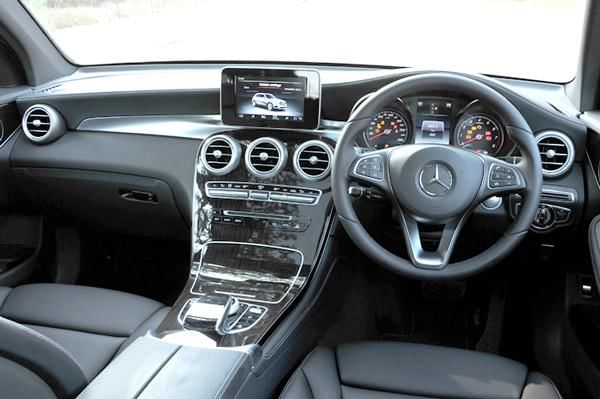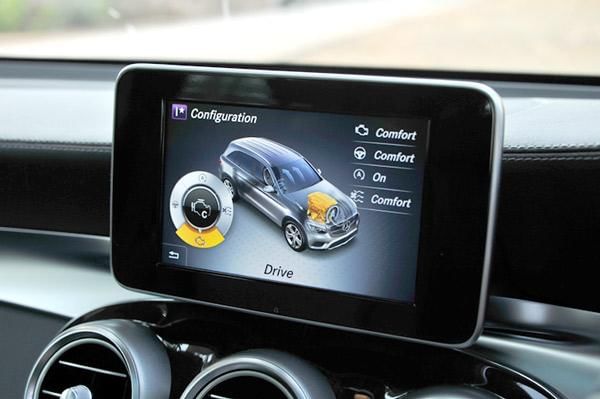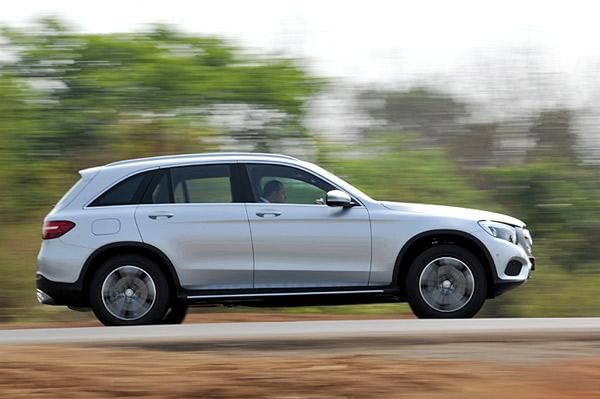Mercedes GLC India review, test drive
Mercedes finally plugs the only serious gap in its model range with the new GLC; an SUV that promises to the spoil Audi Q5 and the BMW X3’s party.
Updated on Jun 06, 2016 05:58:35 PM
32,004 Views
Follow us on



What is it?
It’s hard to believe that after Maruti, it’s Mercedes that has the widest model range in India. What’s even harder to believe is that there exists a big hole in Mercedes’ burgeoning portfolio, which has taken ages to fill. Now finally, the long, long overdue Mercedes GLC is finally here to plug that crucial gap in the meat of Mercedes’ SUV range, which happens to be bang in between the compact GLA and the meaty GLE.
So far, Mercedes could only helplessly watch potential mid-size luxury SUV buyers turn to the Audi Q5 and BMW X3 instead, but now, the GLC is here with a vengeance to spoil its rivals’ party. But can it steal their sales? To know the answer, we took the GLC for a long and gruelling drive.

| Mercedes-Benz GLC Price, Mileage, Specifications, Features and Variants | |
|---|---|
| Brand | Mercedes-Benz |
| Model Name | GLC |
| Mercedes-Benz GLC Price | NA |
| Mercedes-Benz GLC Range/Mileage | NA |
| Mercedes-Benz GLC Specifications | SUV | 5 doors | 5 seats View All Specs |
| Mercedes-Benz GLC Features | LED headlight | 7-inch Screen display | 7 airbags View All Features |
| Mercedes-Benz GLC Variants | 220d Style 4MATIC | 300 Sport 4MATIC | 220d Sport 4MATIC View All Variants |
It’s based on the same platform as the C-class and the wheelbase has been stretched by 33mm. But what also makes it look big is the tall cabin and the wide nose. Mercedes’ new design language, known internally as ‘sensual purity’, blends bold details on the one hand and a sinewy basic form, on the other.
Up front, the wide grille stands out as it protrudes from the bonnet and grabs your attention first. The next thing you notice is just how clean the flanks of the GLC are and how neatly the wheel arches bulge out. I also particularly like the treatment of the GLC’s rear, which has a bit of a coupé-like feel to it with the swoopy D-pillar and raked rear screen while the chunky rear skid plate with twin exhausts housed in them are there to remind you of the GLC’s SUV credentials. What does look a bit odd, however, is how far forward the front wheels have been pushed in the interest of better interior packaging; but it does upset the proportions a bit.
What’s it like on the inside?
The GLC’s classy and premium cabin is very similar to that of the C-class, which completely blew our socks off back in 2014, and it comes with the same exemplary build quality. The wide, wooden centre console with the array of chromed vents, the metal-finish buttons, the beautifully layered dash and the plush doorpads with double-stitched everything just give the cabin an incredible lift. There are a few bits that don’t quite resonate at the same pitch as the rest of the cabin, though. The dials look very ordinary, there are some stray bits of cheap plastic around and Merc’s COMAND system, which though better than before, still feels a bit archaic. Making it worse is the small, seven-inch infotainment screen.

No such complaints with the seats though, which are large and generous all round. The front seats, which have a long back rest and squab, offer generous all-round support. Getting the right driving position is also a cinch; especially with the powered seats and powered steering adjustment, which is standard on the GLC 300.
Rear-seat space is where the GLC really scores and overall comfort promises to be the best in class. It’s more comfortable than the C-class too – you are sat higher, there’s good legroom and headroom for even large passengers, and the seats feel well cushioned. The only niggle is that the seat base is a bit too short and this compromises under-thigh support. The middle passenger is naturally not as comfy, but because the air-con vent doesn’t protrude as much and the generous footwells allow him to spread out a bit, he’s better off than in other SUVs.

Boot space is very impressive too. The GLC has 550 litres of it, and that’s expandable if you flip down the powered seat backs. The only problem is that much of the boot is taken up by the spare wheel, and getting a big set of bags on top of that is strenuous.
What’s it like to drive?
In the not-too-distant past, a ‘300’ badge would have suggested a 3.0-litre engine, but this motor is a 2.0-litre, four-cylinder turbo-petrol unit pushing out a V6-like 245hp and 370Nm of torque, which seems more than adequate for a 1,871kg car, especially since it’s mated to Mercedes’ latest gearbox. In place of the old 7G-Tronic is a nine-speed torque-converter automatic with the extra ratios here for better overall performance and economy.
The gearbox does its job beautifully. In ‘Comfort’ mode, it behaves like the quintessential Mercedes unit. It is smooth and jerk-free and the fact that it has nine speeds means there are smaller gaps between ratios and this helps make the transition between gears fairly seamless. That’s not the case when you toggle the Drive selector into the most aggressive Sport+ mode where there’s a distinct thud between shifts when you accelerate hard. The GLC 300 comes with five different driving modes – Comfort, Eco, Sport, Sport+ and Individual – which alter the steering, throttle and transmission parameters. The suspension, however, which sits on steel springs, cannot be altered.

The GLC’s petrol motor has a pretty wide powerband and delivers its grunt quite progressively. There isn’t much turbo lag, but from low revs, there’s not much oomph either and instead, just a nice, gradual build-up of power with the engine really getting into its stride after 3,500rpm. Keep the pedal pinned and you can feel the GLC accelerate hard in a linear and progressive way, with no let up till the 6,500rpm redline. In fact, the action is concentrated between 4,000 and 6,500rpm which tempts us to constantly use Sport and Sport+ which gamely hang onto each gear until the redline. Downshifting from high revs via the paddles provides a great degree of control and on a twisty road, you really feel like you’re driving a manual.
The GLC 300 despatches 100kph in a brisk 7.5 seconds, which makes it faster than its four-cylinder diesel rivals. However, in the real world, especially when you want to make a quick and easy overtaking manoeuvre, you miss the kick of a strong turbo-diesel, which the GLC, with a relatively weak mid-range, certainly lacks. Part-throttle response is pretty good, though, which makes the GLC 300 easy to drive and live with.
What’s also impressive is how hushed the cabin is. Yes, this is the petrol version and the roads are reasonably smooth, but it feels eerily quiet for an SUV doing 80kph. Sounds from the suspension are successfully muffled and even wind around the A-pillar and mirrors is a gentle rustle. Noise levels rise gently when I accelerate hard and the four-cylinder engine gets quite buzzy near the redline. But it’s not to the point of feeling harsh or thrashy, which is why you don’t mind exploiting this motor’s strong top end.
The GLC also comes in a diesel variant; the base GLC220d which puts out a modest 170bhp. It may seem insufficient to propel a car weighing nearly two tonnes but thanks to nine gear ratios making full use of the decent 400Nm of torque, the diesel GLC doesn’t feel underpowered. It’s responsive of the mark and the stronger mid-range compared to the petrol makes it a better car for highway cruising. It’s remarkably refined too at moderate revs and the superb cabin insulation filters out the engine noise really well. However, when you rev the engine beyond 3,000rpm the characteristic diesel drone get quite loud. Also, this engine doesn’t like being revved too hard and feels a bit labored at the top end. Performance isn’t quite scintillating and the way the turbo spools up is more like a strong nudge than a solid kick.

The GLC drives like a jacked-up C-class and strikes a good balance between ride and handling. The pliant suspension and relatively tall 60-profile tyres smoothen out sharp edges remarkably well. In fact, the supple and refined nature of the suspension makes the GLC the most comfortable SUV in its class. At high speeds on undulating surfaces, the softly sprung GLC does move around a fair bit – it tends to pitch quite a lot at the rear and there’s even a side-to-side rocking motion when the road is really uneven. The ride may not be as flat or controlled as in the C-class sedan but it’s not to the point of truly unsettling the passengers.
The GLC’s steering really stands out for its very progressive and linear feel reminiscent of the old hydraulically powered units. Mercedes has got the on-centre feel spot on; there’s no dead zone around the straight ahead position and neither is it too quick off centre to make the GLC nervous at speed. It’s not particularly quick or very direct but for relaxed yet fast driving, it instills a lot of confidence, especially at high speeds.
Push the GLC with verve and you can tell it isn’t the sportiest SUV around. Yes, it is well balanced in corners and feels pretty stable even over mid-corner bumps, but it doesn’t feel agile and enthusiastic for rapid direction changes and there’s a fair bit of body roll. Though the four-wheel drive is meant to be set up for a rear bias, it’s obviously set up to understeer, with the front wheels breaking traction under hard acceleration out of corners (with traction control switched off, of course). It doesn’t have the rear-wheel-drive balance of an X3 and doesn’t feel as playful either.
Should I buy one?
The GLC’s fundamental strength stems from the fact that it is a great all-rounder appealing to a wide swathe of luxury SUV buyers. Firstly, it looks very modern and contemporary and the cabin too is pretty spacious and very well equipped. Yes, there are few niggles like the below-par infotainment system and it may not have the engaging driving dynamics of its rivals. But if you want comfort and refinement, the GLC 300, with its smooth and brisk performance, supple ride and hushed cabin, is hard to beat.
Most buyers are likely to opt for the entry-level GLC 220d which is a more practical choice. Mercedes has priced the SUV at Rs 50.70 lakh for the diesel GLC 220d 4Matic and Rs 50.90 lakh (ex-showroom, Pune) for the GLC 300 4Matic petrol. If you’ve always wanted a Merc and have often looked at a luxury SUV, make sure you check out the GLC first. It just could be the right car for you.
| Specifications | ||
|---|---|---|
| GLC 300 4MATIC | GLC 220 d 4MATIC | |
| Fuel | Petrol | Diesel |
| Engine Displacement | 1991cc | 2143cc |
| Power | 245hp at 5500rpm | 170hp at 3000-4200rpm |
| Torque | 370Nm at 1400-2800rpm | 400Nm at 1400-2800rpm |
| Gearbox | 9-speed automatic | 9-speed automatic |
| Length | 4656mm | 4656mm |
| Width | 1890mm | 1890mm |
| Height | 1639mm | 1639mm |
| Wheelbase | 2873mm | 2873mm |
| Kerb Weight | 1871kg | 1954kg |
| Tyre Size | 235/60 R18 | 235/60 R18 |
| Boot Volume | 550 litres | 550 litres |
| Mercedes GLC diesel vs rivals prices (ex-showroom, Pune) | |||
|---|---|---|---|
| Mercedes GLC | Volvo XC60 | Audi Q5 | BMW X3 |
| 220 d - Rs 50.7 lakh | Kinetic - Rs 49.92 lakh | Premium - Rs 48.44 lakh | Expedition - Rs 49.4 lakh |
| --- | Momentum - Rs 53.14 lakh | Premium Plus - Rs 51.54 lakh | xLine - Rs 56.06 lakh |
| --- | Inscription - Rs 55.90 lakh | Technology - Rs 55.44 lakh | MSport 30d - Rs 62.92 lakh |
Copyright (c) Autocar India. All rights reserved.







Comments
Member Login
Personal Details
No comments yet. Be the first to comment.